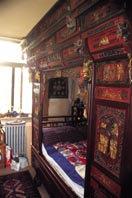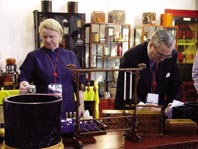In the early 1990s the Smiths decided to make a wedding gift of a Qing Dynasty (1644-1911) wardrobe to their Chinese friend. Upon consulting her she told them she would prefer a Western style wardrobe as in her view, it would be more stylish. In the end, and to the delight of the prospective bride, the couple presented her with the latest design composite wardrobe. In the ten or so years since, however, antique style furniture has come to be regarded as the epitome of fashion, taste, affluence and social standing. By 2003, the wardrobe the Smiths had originally planned to buy was a rare commodity, and its price had tripled.

In 1994, the price of a pair of old-style mahogany armchairs sold in Tianjin's antique market soared from one hundred or so yuan to over a thousand in the space of six months. In 1998, a Ming Dynasty (1368-1644) rosewood scented screen went under the hammer at Christie's, New York for US $1.1 million, and in 2000 a pair of Qing Dynasty red sandalwood chests sold for 3.98 million yuan at a Tianjin auction. In spring 2003, a set of 12 red sandalwood inlay paneled screens from the Kangxi period (1662-1722) were sold to an anonymous Shanghai businessman at a Christie's auction for a staggering 25 million yuan.
In the past ten years the antique furniture market has visibly expanded from just a few shops in scattered locations to replica antique furniture streets lined with shops in Beijing, Shanghai, and Hangzhou. In the early 1990s, there were only ten antique furniture companies in Beijing; today there are 2,000.
As competition heats up, antique furniture returns shrink. In the mid-1990s, profits of the well-known Beijing Huayi Antique Furniture Co., Ltd. increased at an average annual rate of 40-50 percent, compared to less than 10 percent today.
Furniture currently on sale consists of new designs in old and new timber and old designs in new timber. Says Luo Maisheng, executive deputy general manager of Huayi: "Nowadays, genuine antique furniture and rare wood is scarce, and Ming and Qing furniture made of rare timber is nowhere to be found." New classic-style furniture is hand-made and so sells at four to five times the price of standard pieces. A skilled old style furniture craftsman earns 8,000 yuan per month, an amount far in excess of that earned by his less specialized fellows, and a master craftsman's monthly salary often exceeds 10,000 yuan.
Luo Maisheng has adopted various tactics to stay ahead of the situation. He is an habitual browser at antique furniture markets and sends his sales staff to new high-grade residential blocks to canvas for potential customers. He has also signed cooperation agreements with various home decoration companies.
Founded in 1990, the Huayi Antique Furniture Co., Ltd's first customers were overseas residents and business people from Taiwan, Hong Kong, and Macao. Later, people from cultural and arts circles, those newly returned from abroad and newly successful entrepreneurs swelled its domestic custom.
Most of the Smiths' antique furniture comes from Huayi. Their favorite piece is a Qing Dynasty ornately carved wooden bed that they bought for 600 yuan in 1993. Just four years later they saw a similar dragon and phoenix carved bed of the same period priced at 37,000 yuan.
Like many overseas residents, the couple makes alterations to antique pieces for reasons of function. They modified a traditional Chinese style wardrobe by installing poles, partitions, and drawers, found an old style kitchen cupboard the perfect receptacle for shoes, keep receipts and other bric-a-brac in a medicine cupboard, and hang cups on an exquisitely carved window lattice.
Having helped another foreign customer adapt a Chinese style wardrobe into a Western style wine cabinet, Zhang Huanrong, general manager of Beijing Shangzhiyu Culture Company is qualified to comment. She observes, "Most overseas customers make modifications to antique items of furniture for practical purposes, whereas Chinese customers like to retain the original appearance."
After working as a reporter on the furniture industry for five years, in late 2002 Zhang Huanrong founded an antique furniture and porcelain company whose emphasis, in contrast to Huayi, is on individuality. She buys antique furniture, makes replicas and also modifies original pieces, such as the bench that was originally an old manger. In order to expand sales channels, she has invited experts from the Palace Museum to give lectures to antique enthusiasts. She has also signed a seven-year contract with the Palace Museum permitting her to make replicas of its rare collection on the proviso that the museum administrators conduct strict quantity and quality supervision, nominate specific manufacturers and train workers. "The Palace Museum employs a large number of senior highly skilled craftsman but has no apprentices. My strategy will fill this gap and also draw the attention of collectors. Proceeds of pieces sold at auction will go towards the purchase of rarer pieces." Zhang is confident in the effectiveness of applying modern techniques of painting and manufacture to making replicas. She is currently in negotiation with Dutch and Swedish agents as regards developing overseas markets.

Pirating is one of the biggest problems within the Chinese furniture industry. Once a custom-made individual piece has been made, its value is often negated by entry into the market of large numbers of modified versions, or out-and-out imitations. "Foreign furniture companies are loath to attend Chinese furniture exhibitions because they run the risk of their products being copied before even entering the market," says Zhang ruefully.
Bigger enterprises often make patent applications for their designs, but certain firms admit that the nature of the furniture industry invalidates the protective function of patents. Applications cost time and money, and in the process floods of imitations emerge, so nullifying the whole concept.
According to Luo Maisheng, copying cannot be stopped, and the only way to survive, prevent competitors from purloining designs and keep one step ahead is by regular promotion of new, distinctive creations.
(China Today September 10, 2004)

